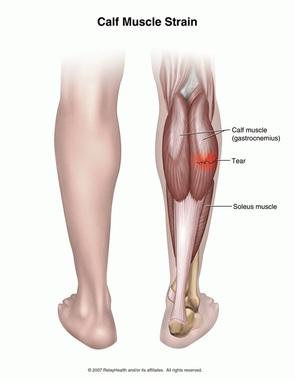What Is a Calf Strain?
A calf strain is a common sports injury that occurs when the calf muscle fibres in the back of the lower leg are damaged by over-stretching or excessive force.
Anatomy
The calf muscles are made up of 4 different individual muscles (2 heads of gastrocnemius, soleus and plantaris) which attach to the heel via the Achilles tendon. These muscles work to plantarflex (point) the ankle, stablise the ankle joint and assist with bending the knee.
How do People Strain Their Calf?
Calf strains are common in sports that involve quick acceleration from a stationary position and halts in movement (e.g. tennis and soccer). These movements tend to "overstretch" and disrupt the muscle fibres as they are stressed beyond their ability to stretch. Calf strains may be more common in athletes who have "tight calves" and/or "stiff ankles" and can occur as an overuse-type injury (e.g. in runners).
Symptoms
There are two ways people typically report calf strains:
- Sudden onset, sharp pain (inciting event) - where an individual notices a sudden onset heat or sharp pain which may sometimes feel like a "shot to the back of the leg" during a memorable activity or movement.
- Gradual onset, dull ache - where an individual notices worsening leg "tightness" towards the end of an activity (e.g. end of a footy match or end of a run), leading to weakness and an inability to continue.
Diagnosis
Typically, people with calf strains will present with:
- Pain with walking,
- Pain while using the muscle (plantarflexion/pointing) or
- Pain while stretching the muscle (dorsiflexion).
- Redness
- Bruising
- Swelling and
- Weakness of the leg
Physios will be able to diagnose a calf strain depending on the severity of the injury and prioritise ruling out other sinister causes of leg pain which can include: deep vein thrombosis, (referred) nerve pain and compartment syndrome.
Healing Time & Prognosis
Healing time depends on the severity of the injury. There are 3 main grades of calf strains:
- Grade 1: Less than 25% of the muscle fibres are torn during the injury. The pain is normally mild and the athlete normally returns to sport within 1-3 weeks post-injury. It is important to know that re-injury risk of a calf strain is highest within the first 40 days of the initial injury (16%).
- Grade 2: Between 25%-90% of torn muscle fibres, often associated with noticeable limping, bruising and swelling in the calf and ankle. Normally between 4-8 weeks for a return to sport.
- Grade 3: A grade 3 injury is when > 90% of the fibres have torn and can include a complete rupture of the calf muscle. This injury is extremely painful, and often the individual may need crutches or a moonboot to assist with walking. If the muscle is completely ruptured, surgery may be required. A grade 3 injury can take 3-9 months to return to sport.
Acute Calf Strain Management
Following a calf strain, the acute phase of soft tissue healing is no different to the management of other soft tissue injuries : follow the RICE principle:
- R: Rest (or relative rest) to allow the tissue time to heal to avoid further injury
- I: Ice: apply ice for 5 minutes every 15-20 minute intervals to minimise pain and swelling. This is crucial within the first 4 hours of the injury. Cold burns may occur, so be mindful of skin contact and sensitivity.
- C: Compression: use a bandage or compression sleeve to minimise swelling and bleeding.
- E: Elevation: elevating your leg above the heart level facilitates good drainage to minimise swelling in the legs
Physiotherapy Management
It is important to seek the care of your physiotherapist to ensure that your post-injury recovery is timely and graduated to allow a fast and safe return to sport. Most calf injuries will fully heal with conservative management.
It is very important to strengthen the calf once the acute phase has settled, and build tolerance to walking, jumping, hopping and running again. In most competitive sports, return to running is often delayed with a more conservative approach due to the high rate of re-injury.
Once the ankle movement has returned, the athlete is painfree with walking and they are able to achieve specific calf and ankle milestones (e.g. single leg heel rise test, repetitive hopping tests), a physiotherapist can help provide a loading and rehabilitation plan that is sport-specific to get you them back on the field ASAP!
The rehabilitation timeline is not complete without an injury prevention plan, which normally involves heavy calf strength training in both standing (heel rises) and sitting (bent knee heel rises) and plyometric (hopping, jumping) training to improve power, tendon strength and maximise performance outcomes.

